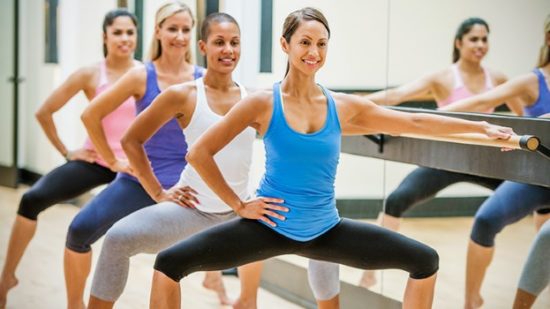Are you one of the many who could use some musical assistance when getting your…
Raise the ‘Barre’ – 6 Exercise Secrets We Learned from the Barre Workout

A Full-Body Workout for the Masses
Whether you’re training for your first 5K or want to get in shape for summer, you might want to consider adding barre to your strength-training workouts. While this trendy exercise is inspired by ballet movements, the resulting workout is much more accessible and is quickly making the jump from boutique fitness craze to the class schedule at your local gym. Barre’s subtle isometric exercises, in which your body remains still while you contract a specific muscle, are designed to give you a full-body workout and build lean muscle. This low-impact exercise also makes a great sweat session for people with joint issues or women who want to stay in shape throughout their pregnancy.
Make Your Reps Count
The beauty of barre is that it doesn’t measure strength by the number of pounds you can lift but instead, by the number of reps you can do. During a barre workout, you will do a series of isometric movements that target specific muscle groups. What makes these movements challenging is that you work smaller muscles — particularly ones that you may not be used to engaging — in conjunction with larger muscle groups and perform these movements in a certain number of reps. What’s great about barre is that it focuses on muscle endurance and building well-rounded strength. For example, in the Narrow V position, you are working the lateral rotators and the gluteus minimus, which are a smaller group of muscles in the hip area. At the same time, you’re engaging the larger muscles of the legs, including the quadriceps and hamstrings. And as you press your heels against the floor, it creates internal pressure in your inner thigh muscles.
Work Out in Angles
Similar to yoga and Pilates, barre focuses on strengthening your core, which includes your abs, pelvis, and glutes, but what makes barre exercises stand apart are the different movement systems. Barre workouts progress from building stability in your core to engaging other muscles in your body. The movements are very subtle, so it’s important to pay attention to all the small details in the way you position your body. The way you angle your leg around your body can make all the difference in the concentration of the muscle you’re working out. Making these angles with your body while doing similar movements will continually challenge your body. The way you position your legs in the All Fours is a good example of how the slightest change can make all the difference. When you extend one leg straight behind you with your shoe laces facing the mat, you primarily work out your glutes, hamstrings, and larger muscles. But when you turn your shoe laces to the side, you engage lateral rotators and other smaller muscles.
Less Is More
If you’ve ever taken a barre class, you’ll notice that the hand weights used are between 3-5 pounds, or you may have not have used weights at all. That’s because barre is about using your body weight as resistance, which makes it an easy no-equipment workout to do at home. Barre exercises use your body creatively to create opposition. Classic barre exercises include modifications of planks and push-ups with well-timed movements that are designed to hit every part of our body. You’d be surprised at how much harder you have to work to do a plank without using one of your arms or raising a leg off the ground.
Get Used to Being Uncomfortable
One of the basic principles of barre is making the mind-body connection. Because barre involves making a lot of intricately-timed movements, the key to making the most out of your workout is to be mentally present while doing the exercise. The biggest challenge with barre is mental. You have to commit and trust in it and allow yourself to burn. The strength is in the struggle. We don’t get stronger in our comfort zone; it’s really about developing mental endurance. You can apply this same method to your daily workout. Whether you’re training for your first 5K race or perfecting a yoga headstand, half the battle is mastering mental endurance and fighting through the burn. We all become stronger outside of our comfort zones and that’s when you see real progress.
Low-Impact Doesn’t Mean Low Intensity
Barre is a great low-impact workout for everyone at any fitness level; it’s as safe and effective as a prenatal exercise, if you have joint issues, or if you are recovering from an injury. But it doesn’t mean that it’s any less intense. Doing multiple reps of the small isometric movements creates intensity and opposition. Many people feel their muscles “burn” after doing a certain number of reps, but it’s important to keep up with the intensity in order to see the difference in your workouts. Work against yourself and it will intensify your workout. The key is knowing the difference between burn and pain. It allows you to go beyond your limits.
Your Best Self Isn’t Always a “Lean” Look
If you’re looking to achieve a lean dancer’s body, barre can help you achieve those goals — but only to a certain extent. Barre is not a muscle gain program. It’s about high reps and low weight, which helps build muscle endurance. This can, in turn, create a ‘lean’ look, but you shouldn’t try to force your body into something it is not. Barre is a lifestyle that helps you be the best version of yourself. This is an important takeaway to apply to all forms of exercise, whether you’re a swimmer, power walker, or dancing it out in Zumba. The goal of any workout routine is to achieve your own, personal level of healthy — whatever that may look like for you.
Article adapted via



